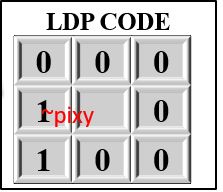New Post
Local Directional Pattern (LDP)
- Get link
- X
- Other Apps
Local Directional Pattern
What are Local Directional Patterns?
LDP = Local Directional Pattern. Local Directional Pattern is a descriptor i.e., used for Face Recognition.
What is Descriptor?
Descriptors rely on Gradient-based or intensity variation approaches detect Local Features (e.g., Edges, Blobs and Regions). BLOB = Binary Large Object (i.e., the region of the image). Descriptors such as HOG, SIFT, SURF (rely on local gradient computation). Binary Descriptors such as BRISK, ORB or FREAK (rely on local intensity differences). Local Directional Pattern (LDP) Assign code for each pixel in the image. Local Directional Pattern (LDP) encoded image is divided into regions.
How LDP Calculate?
For Each pixel in the image LDP computes an 8-bit binary code. 8-bit binary pattern is calculated by involving the local regions of the image of size 3x3 with Krisch Mask in 8 Directions. Local Directional Pattern (LDP) Local Region’s Values:
What is Kirsch Compass Mask?
Local Directional Pattern (LDP) is Based on the known KIRSCH MASK. Kirsch Mask is non-linear Edge Detector. Using Kirsch mask we can find Edges in the following 8 direction: North, North West, West, South West, South, South East, East, North East.
How to Calculate Local Directional Pattern Value?
Calculate East Direction Mask i.e., 𝑚_0
E (East)
E = [ (5 * 30) + (5 * 25) + (5 * 10) + (-3 * 50) + (-3 * 40) + (-3 * 45) + (-3 * 55) + (-3 * 15) + (0 * 60) ]
E = [ 150 + 125 + 50 – 150 – 120 – 135 – 165 – 45 – 0 ]
E = [– 290 ]
Calculate North Direction Mask i.e., 𝑚_2
N (North)
N = [ (5 * 55) + (5 * 15) + (5 * 30) + (-3 * 25) + (-3 * 10) + (-3 * 50) + (-3 * 40) + (-3 * 45) + (0 * 60) ]
N = [275 + 75 + 150 – 75 – 30 – 150 – 120 – 135 – 0 ]
N = [– 10]
Calculate South Direction Mask i.e., 𝑚_6
S (South)
S = [ (5 * 10) + (5 * 50) + (5 * 40) + (-3 * 45) + (-3 * 55) + (-3 * 15) + (-3 * 30) + (-3 * 25) + (0 * 60) ]
S = [50 + 250 + 200 – 135 – 165 – 45 – 90 – 75 – 0 ]
S = [– 10]
Calculate West Direction Mask i.e., 𝑚_4
W (West)
W = [ (5 * 55) + (5 * 45) + (5 * 40) + (-3 * 50) + (-3 * 10) + (-3 * 25) + (-3 * 30) + (-3 * 15) + (0 * 60) ]
W = [275 + 225 + 200 – 150 – 30 – 75 – 90 – 45 – 0 ]
W = [ 310]
(MSB, also called the high-order bit). the high-order bit or left-most bit
LDP is formed Considering only first 3 values of sorted Edge Response in descending order (i.e., largest to smallest).
LDP code for K = 3 is computed as:
𝑚_5 = 270 (3rd most significant directional response).
Calculate LDP Code of the pixel (x , y) :
〖 𝑳𝑫𝑷〗_(𝒙,𝒚) (𝒎_𝟎…𝒎_𝟕 )= ∑_𝟎^𝟕▒〖𝒔 (𝒎_𝒊−𝒎_𝟓 )∗𝟐^𝒊 〗
Calculate LDP Binary Code of the pixel (x , y)
〖 𝐿𝐷𝑃〗_(𝑥,𝑦) (𝑚_0…𝑚_7 )= ∑_0^7▒〖𝑠 (𝑚_𝑖−𝑚_5 )∗2^𝑖 〗
For i = 0,
〖𝐿𝐷𝑃〗_(𝑥,𝑦) (𝑚_0…𝑚_7 ) = ∑_0^7▒〖𝑠 (𝑚_0−𝑚_5 )∗2^0 〗
〖𝐿𝐷𝑃〗_(𝑥,𝑦) (𝑚_0…𝑚_7 ) = ∑_0^7▒〖𝑠 (−290−270)∗1〗
〖𝐿𝐷𝑃〗_(𝑥,𝑦) (𝑚_0…𝑚_7 ) = ∑_0^7▒〖𝑠 (−560) 〗 * 1
− 560 < 0
0 * 1
0
For i = 1,
〖𝐿𝐷𝑃〗_(𝑥,𝑦) (𝑚_0…𝑚_7 ) = ∑_0^7▒〖𝑠 (𝑚_1−𝑚_5 )∗2^1 〗
〖𝐿𝐷𝑃〗_(𝑥,𝑦) (𝑚_0…𝑚_7 ) = ∑_0^7▒〖𝑠 (−250−270)∗2〗
〖𝐿𝐷𝑃〗_(𝑥,𝑦) (𝑚_0…𝑚_7 ) = ∑_0^7▒〖𝑠 (−520) 〗 * 2
− 520 < 0
0 * 2
0
For i = 2,
〖 𝐿𝐷𝑃〗_(𝑥,𝑦) (𝑚_0…𝑚_7 ) = ∑_0^7▒〖𝑠 (𝑚_2−𝑚_5 )∗2^2 〗
〖 𝐿𝐷𝑃〗_(𝑥,𝑦) (𝑚_0…𝑚_7 ) = ∑_0^7▒〖𝑠 (−10−270)∗4〗
〖 𝐿𝐷𝑃〗_(𝑥,𝑦) (𝑚_0…𝑚_7 ) = ∑_0^7▒〖𝑠 (−280) 〗 * 4
− 280 < 0
0 * 4
0
For i = 3,
〖𝐿𝐷𝑃〗_(𝑥,𝑦) (𝑚_0…𝑚_7 ) = ∑_0^7▒〖𝑠 (𝑚_3−𝑚_5 )∗2^3 〗
〖𝐿𝐷𝑃〗_(𝑥,𝑦) (𝑚_0…𝑚_7 ) = ∑_0^7▒〖𝑠 (110−270)∗8〗
〖𝐿𝐷𝑃〗_(𝑥,𝑦) (𝑚_0…𝑚_7 ) = ∑_0^7▒〖𝑠 (−160) 〗 * 8
- 160 < 0
0 * 8
0
For i = 4,
〖𝐿𝐷𝑃〗_(𝑥,𝑦) (𝑚_0…𝑚_7 ) = ∑_0^7▒〖𝑠 (𝑚_4−𝑚_5 )∗2^4 〗
〖𝐿𝐷𝑃〗_(𝑥,𝑦) (𝑚_0…𝑚_7 ) = ∑_0^7▒〖𝑠 (310−270)∗16〗
〖𝐿𝐷𝑃〗_(𝑥,𝑦) (𝑚_0…𝑚_7 ) = ∑_0^7▒〖𝑠 (40) 〗 * 16
40 ≥0
1 * 16
16
For i = 5,
〖𝐿𝐷𝑃〗_(𝑥,𝑦) (𝑚_0…𝑚_7 ) = ∑_0^7▒〖𝑠 (𝑚_5−𝑚_5 )∗2^5 〗
〖𝐿𝐷𝑃〗_(𝑥,𝑦) (𝑚_0…𝑚_7 ) = ∑_0^7▒〖𝑠 (270−270)∗32〗
〖𝐿𝐷𝑃〗_(𝑥,𝑦) (𝑚_0…𝑚_7 ) = ∑_0^7▒〖𝑠 (0) 〗 * 32
0 ≥0
1 * 32
32
For i = 6,
〖𝐿𝐷𝑃〗_(𝑥,𝑦) (𝑚_0…𝑚_7 ) = ∑_0^7▒〖𝑠 (𝑚_6−𝑚_5 )∗2^6 〗
〖𝐿𝐷𝑃〗_(𝑥,𝑦) (𝑚_0…𝑚_7 ) = ∑_0^7▒〖𝑠 (−10−270)∗64〗
〖𝐿𝐷𝑃〗_(𝑥,𝑦) (𝑚_0…𝑚_7 ) = ∑_0^7▒〖𝑠 (−280) 〗 * 64
-280 <0
0 * 64
0
For i = 7,
〖𝐿𝐷𝑃〗_(𝑥,𝑦) (𝑚_0…𝑚_7 ) = ∑_0^7▒〖𝑠 (𝑚_7−𝑚_5 )∗2^7 〗
〖𝐿𝐷𝑃〗_(𝑥,𝑦) (𝑚_0…𝑚_7 ) = ∑_0^7▒〖𝑠 (−130−270)∗128〗
〖𝐿𝐷𝑃〗_(𝑥,𝑦) (𝑚_0…𝑚_7 ) = ∑_0^7▒〖𝑠 (−400) 〗
-400<0
0 * 128
0
Calculated LDP Code = 0 * 𝟐^𝟎+"0 ∗ " 𝟐^𝟏+"0 ∗ " 𝟐^𝟐+"0 ∗ " 𝟐^𝟑+"1 ∗ " 𝟐^𝟒+"1 ∗ " 𝟐^𝟓 " +0 ∗ " 𝟐^𝟔+"0 ∗ " 𝟐^𝟕
〖 𝑳𝑫𝑷〗_(𝒙,𝒚) (𝒎_𝟎…𝒎_𝟕 ) = (0 * 1) + (0 * 2) + (0 * 4) + (0 * 8) + (1 * 16) + (1 * 32) + (0 * 64) + (0 * 128)
〖 𝑳𝑫𝑷〗_(𝒙,𝒚) (𝒎_𝟎…𝒎_𝟕 ) = 16 + 32 = 48
LDP CODE = 48
- Get link
- X
- Other Apps














Comments
Post a Comment